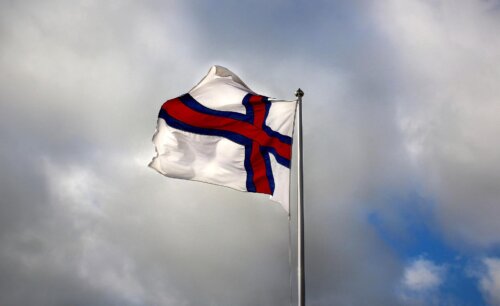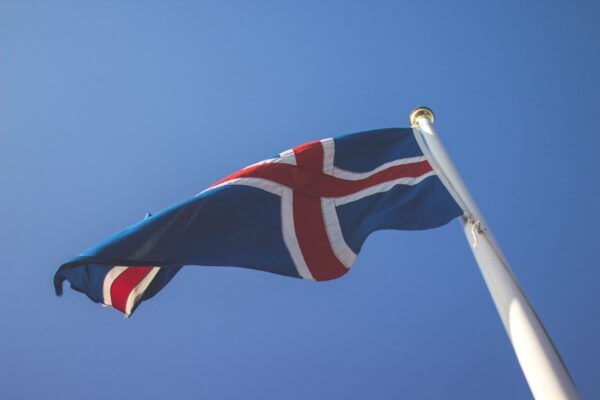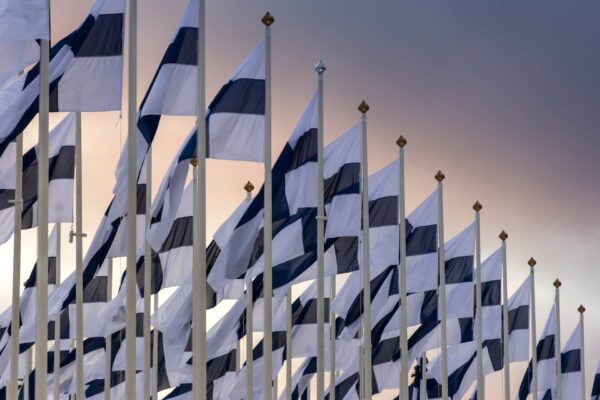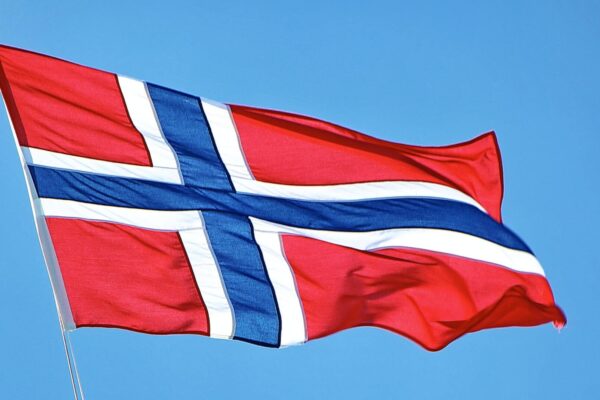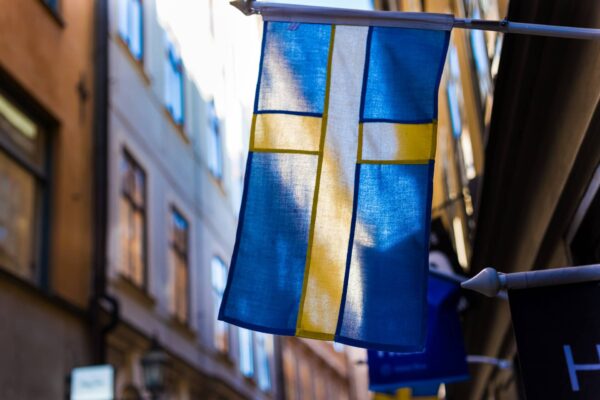The Danish flag is also called Dannebrok, which translates as “flag of the Danes”. The word brók or brok is Old Danish and means cloth or piece of cloth. The flag of Denmark is one of the oldest flags in the world.
What does the Danish flag look like?
The Danish flag, also known as Dannebrog (more rarely Danebrog), shows a white cross on a red background. The red colour is also known as Dannebrok red. A slightly darker version, the so-called madder red, is used instead on the flag of the royal house and the battle flag. The ratio of the red squares is 12 by 12 and that of the red rectangles is 12 by 21 units. The white stripes must be four units wide.
Danish Middle Ages and early modern times: Origin of the Dannebrog
800-1200 AD: Origin of the word Dannebrog
The word brok (originally spelt brók) comes from Old Danish and translates as cloth or piece of cloth. As the flag of Denmark was originally also called Dannebrok, researchers therefore suspect its origin in this period. It is said that the early Danes, the Vikings, hoisted a red cloth.
1219: The myth of the origin of the Danish flag
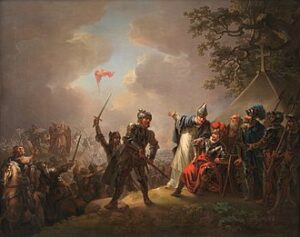
The origin myth takes place on 15 June 1219 at the Battle of Lyndanisse, when a huge flag showing a white cross on a red background fell from the sky and helped King Waldemar II and his Danes to victory.
Late Middle Ages and early modern times: use as a ship’s flag
In the centuries of the late Middle Ages, the current flag of Denmark was used in various forms as a ship’s flag. The oldest surviving Dannebrog ship’s flag from 1427 was burnt in the Palm Sunday bombing in Lübeck in 1942.
1350-1400: First depiction as a field mark
The first depiction of the Danish flag in a field mark of Waldemar IV Atterdag can be found in a Dutch heraldic book estimated to have been written in the late 14th century.
The flag of the Kalmar Union
The Kalmar Union, an alliance of all three Scandinavian states dominated by Denmark, existed in Scandinavia from 1397 to 1523. The flag of the Kalmar Union, also known as the flag of the North, also shows a Scandinavian cross, which was probably taken from the Danebrog, while the colours come from the Norwegian coat of arms.
Modern times: Recognition as the flag of Denmark
1746: The Dannebrog as a special mourning flag
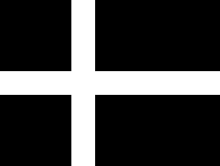
In 1746, a black and white Dannebrog flew on Holmen for two months. The occasion was the death of King Christian VI.
1854: Declaration of the Dannebrog as the national flag of Denmark
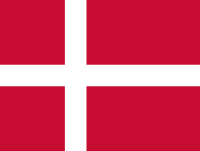
In 1854, the Dannebrog was officially declared the national flag of Denmark. However, the proportions had not yet been determined at this time.
1893: Dispute over the proportions of the Danish flag
On 1 May 1893, a police directive was issued calling on people not to intervene if the proportions of the rectangles on the outside were between 6:4 and 7:4.
Flag Denmark: history
The history of the Danish flag is only partially documented. Some aspects are therefore disputed. For example, it cannot be proven that it is the oldest flag in the world, as many claim. What is certain, however, is that it is one of the oldest flags that has remained unchanged since its introduction. It is said to have originated in the Middle Ages during the Viking Age.
Danish national flag
- Danish: Dannebrog
- presumed origin: 13th century
- first depiction: late 14th century
- officially declared the national flag: 1854
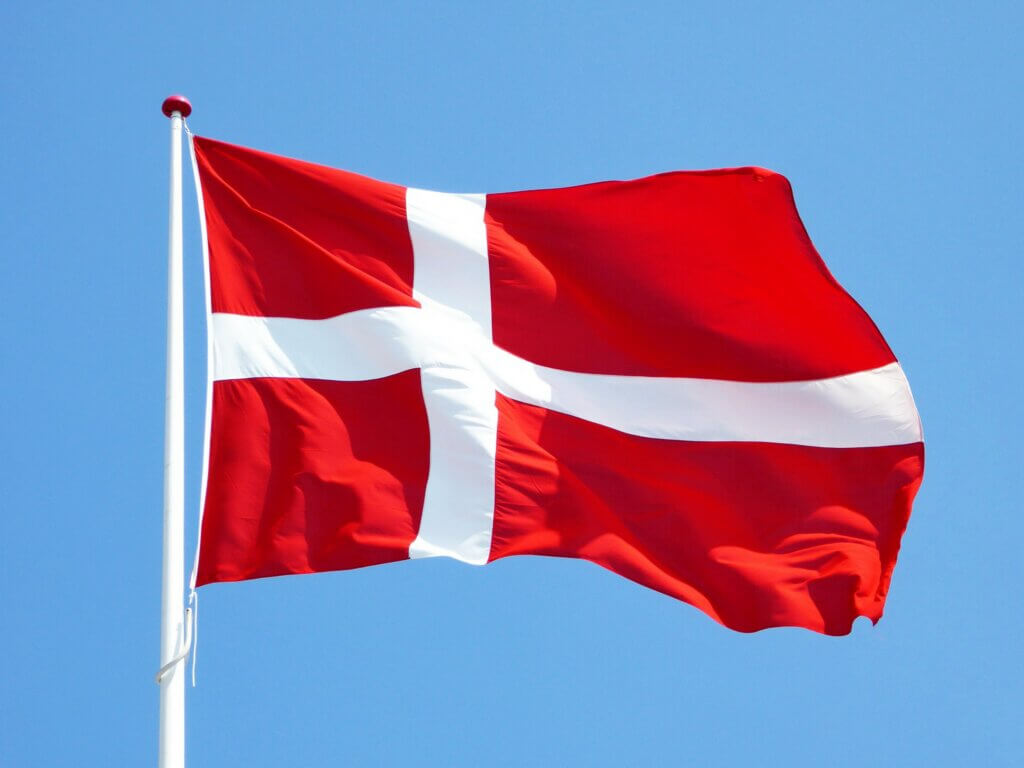
Where does the name of the Danish flag come from?
The Dannebrok is said to have originated in the Middle Ages. The origin of the word also supports this. The old Danish word “brok” (cloth, piece of fabric) dates back to the period between 800 and 1200 AD – according to myth, the Vikings hoisted a red cloth.

The first illustration comes from a Dutch armorial, the Armorial Gelre. It was probably added in the late 14th century by Claes Heynen. However, this was not yet a national flag for all Danes, but the so-called field emblem of King Waldemar IV. Atterdag, who ruled Denmark from 1340 to 1347.
There are also ship flags with the Dannebrog. This is because the cross was a common symbol in seafaring in the late Middle Ages. The oldest surviving Dannebrog was found as spoils of war in St Mary’s Church in Lübeck, where it was burnt in 1942.
The Dannebrog as a national flag
The Dannebrog became the national flag of Denmark in 1854, although the proportions had not yet been laid down by law at that time. It was not until 1 May 1893 that a length of between 6:4 and 7:4 was unofficially established.
The origin myth of the Danish flag

The Danes even have a myth about how they supposedly got their national flag. On 15 June 1219, when King Waldemar II fought against the Estonians in the Battle of Lyndanisse (now Talinn, the capital of Estonia), a huge flag is said to have fallen from the sky and decided the battle in favour of the Danes.
The Danish army under Waldemar II were crusaders who fought against the Estonians, who were still pagan at the time, under the pretext of Christianisation. This gave the history of the origin of the Danish flag a religious component.
Today, however, the cross (known as the Philippus cross in heraldry) tends to symbolise the community of the Nordic countries – as it can also be found on the flags of Sweden, Norway, Iceland and Finland – and even the flags of the Faroe Islands and Åland Islands bear the Philippus cross. The flag of the Kalmar Union also bore the Scandinavian cross and was used by the Nordic Council until 1985.
However, it is also thought to have originated with the Order of St John. Members of this order, which was founded in the 11th century, often fought in Denmark’s medieval armies.
The Dannebrog Order is also said to have been founded during the battles against the Estonians. This Order of Merit is awarded to loyal servants of the Danish state for services to Danish interests, for example in the civil sector or in science.
Facts about the flag of Denmark
Flag of Denmark: classification
Today, the appearance of the Danish national flag is precisely defined. The aspect ratio must be 28:37. The values from the aspect ratio are divided into units of equal size, which are used to indicate the length of individual components in proportion.
For the length, the first red field must be 12 units long, the white area 4 units and the second red field 21 units. This results in a total of 37 units. The other side is divided into two red fields 12 units long, which are also separated by a white strip 4 units long. This results in 28 units.
When is the Danish flag hoisted?
The Danish flag is hoisted on various days throughout the year. In particular, birthdays in the Danish royal family – above all Margrethe II’s birthday on 16 April – as well as commemoration days for the occupation and liberation of Denmark in the Second World War, Christmas and New Year’s Day should be mentioned here. There is also a whole series of variable flag days, which are mainly Christian holidays such as Easter, the Day of Prayer and Repentance and Pentecost.
However, the flag is also often flown for birthdays, school enrolments and other occasions. You will certainly notice this in Denmark, as flagpoles can be found on almost every farm and many houses. The Danes like to fly their flag as often as possible.
On the national days of Greenland (21 June) and the Faroe Islands (29 July), the flag of the respective autonomous region is hoisted. The Greenlandic flag is officially called Erfalasorput, the flag of the Faroe Islands Merkið.
When is Danish Flag Day and how is it celebrated?
The Battle of Lyndanisse took place on 15 June 1219, which is why 15 June is now celebrated as Waldemar’s Day and Dannebrog’s birthday. There are also events and exhibitions throughout the country. in 2019, for example, a bicycle relay took place across the country to mark the 800th anniversary, while Queen Margrethe was on a state visit to Estonia – where the Dannebrog finally fell from the sky.
Another flag day is the official Flag Day, which has been celebrated on 5 September since 2009. On this day, the focus is on the Danish military, especially the soldiers stationed outside Denmark, and you can find even more flags than usual in Denmark.
| 01/01 | New Year’s |
| 05/02 | Birthday of Crown Princess Mary |
| 06/02 | Birthday of Princess Marie |
| Friday in March/April | Good Friday |
| Sunday in March/April | Easter Sunday |
| 09/04 | Commemoration of the occupation of Denmark 1940 |
| 16/04 | Birthday of Queen Margrethe II |
| 29/04 | Birthday of Princess Benedikte |
| 05/05 | Memorial day for the liberation of Denmark 1945 |
| Sunday in May | Ascension Day |
| Sunday in May/June | Whitsunday |
| 26/05 | Birthday of Crown Prince Frederik |
| 05/06 | Day of the Constitution |
| 07/06 | Birthday of Prince Joachim |
| 15/06 | Waldemar’s Day |
| 05/09 | Day in Honour of Soldiers Abroad |
| 25/12 | First Christmas Day |
Flag rules: this must be observed
The Danes love their flag, which is why there is an extensive set of rules on the use of the flag, which runs to a whopping 64 pages. We have summarised the most important rules for you here:
- Flags must be flown from 8:00 in the morning until sunset.
- If a flag is to be flown at night, it must be illuminated.
- However, a pennant may remain on the flagpole day and night.
- The person hoisting the flag may not wear headgear.
- The flag must not touch the ground.
- A damaged or faded flag must be replaced.
- Before the flag may be flown at half-mast, it must first be pulled up to the top (this also applies to hoisting).
- Apart from the Danish flag, only flags of the Nordic countries, the EU and the UN may be flown alone.
Flags of the autonomous regions of the Kingdom of Denmark
Flag of Greenland
The Greenlandic flag is officially called Erfalasorput, which means “our flag”. It shows two horizontal bands, the upper one is white and the lower one is red. There is also a disc, the upper half of which is red and the lower half white. This symbolises glaciers, oceans, fjords and icebergs. The colours also show the connection to Denmark – the missing Scandinavian cross also indicates Greenland’s autonomy. The flag was introduced on 21 June 1985.
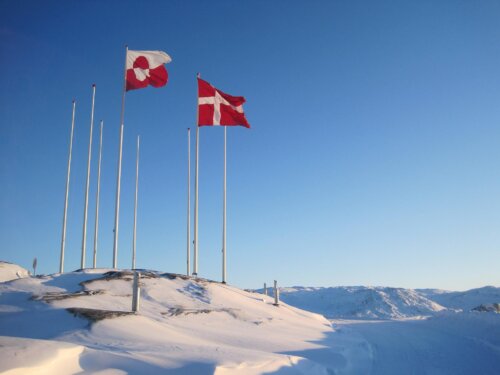
Flag of the Faroe Islands
The Faroe Islands also have their own flag, Merkið (“The Flag”). The flag is a typical Scandinavian cross flag and shows a red cross with a blue border on a white background. The white colour is intended to symbolise the foam of the sea and the radiant sky, while the red and blue indicate the connection to the other Nordic countries. The flag was officially introduced on 25 April 1940, having been designed in 1919.
